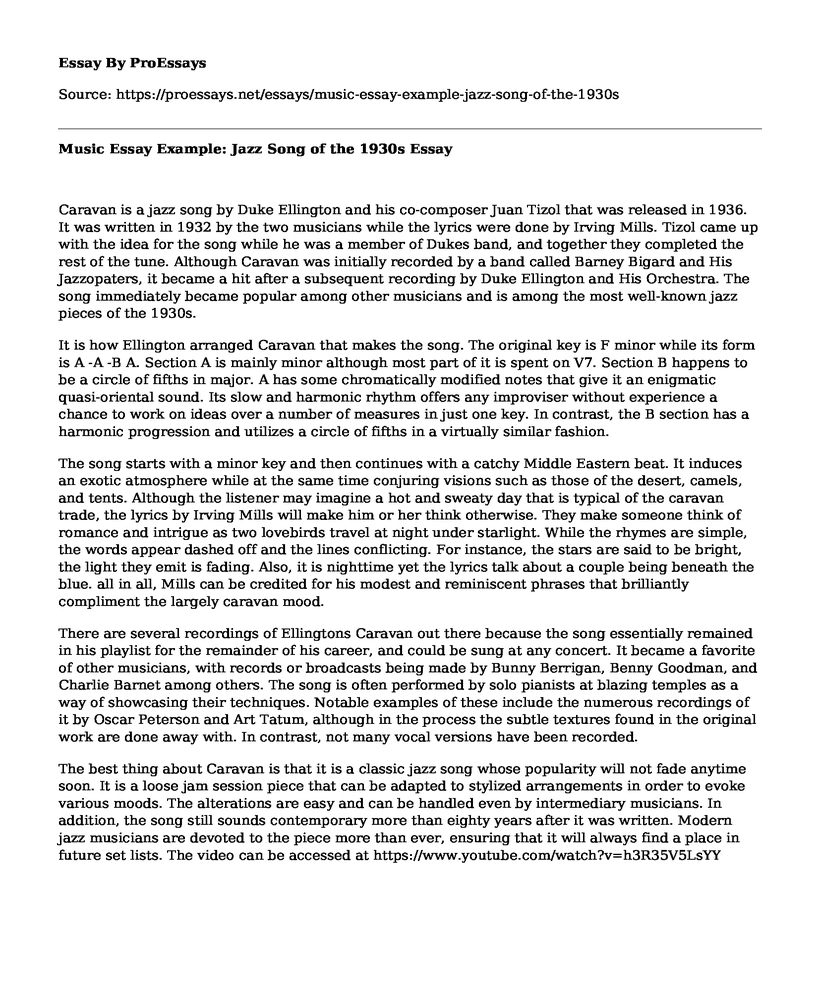Caravan is a jazz song by Duke Ellington and his co-composer Juan Tizol that was released in 1936. It was written in 1932 by the two musicians while the lyrics were done by Irving Mills. Tizol came up with the idea for the song while he was a member of Dukes band, and together they completed the rest of the tune. Although Caravan was initially recorded by a band called Barney Bigard and His Jazzopaters, it became a hit after a subsequent recording by Duke Ellington and His Orchestra. The song immediately became popular among other musicians and is among the most well-known jazz pieces of the 1930s.
It is how Ellington arranged Caravan that makes the song. The original key is F minor while its form is A -A -B A. Section A is mainly minor although most part of it is spent on V7. Section B happens to be a circle of fifths in major. A has some chromatically modified notes that give it an enigmatic quasi-oriental sound. Its slow and harmonic rhythm offers any improviser without experience a chance to work on ideas over a number of measures in just one key. In contrast, the B section has a harmonic progression and utilizes a circle of fifths in a virtually similar fashion.
The song starts with a minor key and then continues with a catchy Middle Eastern beat. It induces an exotic atmosphere while at the same time conjuring visions such as those of the desert, camels, and tents. Although the listener may imagine a hot and sweaty day that is typical of the caravan trade, the lyrics by Irving Mills will make him or her think otherwise. They make someone think of romance and intrigue as two lovebirds travel at night under starlight. While the rhymes are simple, the words appear dashed off and the lines conflicting. For instance, the stars are said to be bright, the light they emit is fading. Also, it is nighttime yet the lyrics talk about a couple being beneath the blue. all in all, Mills can be credited for his modest and reminiscent phrases that brilliantly compliment the largely caravan mood.
There are several recordings of Ellingtons Caravan out there because the song essentially remained in his playlist for the remainder of his career, and could be sung at any concert. It became a favorite of other musicians, with records or broadcasts being made by Bunny Berrigan, Benny Goodman, and Charlie Barnet among others. The song is often performed by solo pianists at blazing temples as a way of showcasing their techniques. Notable examples of these include the numerous recordings of it by Oscar Peterson and Art Tatum, although in the process the subtle textures found in the original work are done away with. In contrast, not many vocal versions have been recorded.
The best thing about Caravan is that it is a classic jazz song whose popularity will not fade anytime soon. It is a loose jam session piece that can be adapted to stylized arrangements in order to evoke various moods. The alterations are easy and can be handled even by intermediary musicians. In addition, the song still sounds contemporary more than eighty years after it was written. Modern jazz musicians are devoted to the piece more than ever, ensuring that it will always find a place in future set lists. The video can be accessed at https://www.youtube.com/watch?v=h3R35V5LsYY
Cite this page
Music Essay Example: Jazz Song of the 1930s. (2021, Sep 02). Retrieved from https://proessays.net/essays/music-essay-example-jazz-song-of-the-1930s
If you are the original author of this essay and no longer wish to have it published on the ProEssays website, please click below to request its removal:
- Civil Architecture and Lessons Derived for Technological Architecture Paper Example
- National Geographic: The Photographic Vision Essay Example
- Female Artist and Producers Role in the Culture of Hip-Hop Music - Essay Sample
- Symbolism in Mark Twain's Adventures of Huckleberry Finn - Essay Sample
- Critical Essay on Cry Freedom: A Historic Drama of Apartheid South Africa
- Essay Sample on Sick Around America: High Medical Bills in US Revealed
- Free Essay Sample on Deion Sanders







